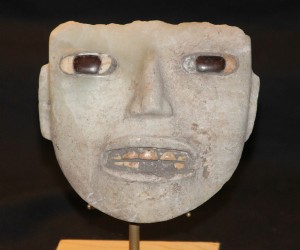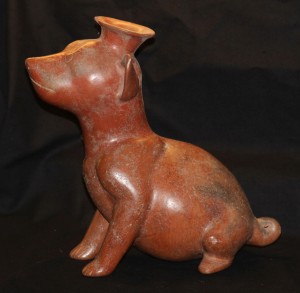Museum of Native American History Receives Donation of Jim Blair’s Meso-American Art Collection
Crystal Bridges isn’t the only state-of-the-art museum in Bentonville highlighting American art. The Museum of Native American History (MONAH) presents the earliest of masterpieces from the original, tribal inhabitants of the Americas.
The extensive artifacts and art on display at the museum are the private collection of David Bogle of Bentonville. His mission is to give visitors a deeper sense of how Native Americans lived. His museum is more than a Bentonville treasure. It is a national repository that honors the lives and cultures of the first Americans.

A substantial addition to the collection debuted March 20 with the donation from Jim and Nancy Blair of their Meso-American art collection.
The Blair collection opens a window to the lives and history of those who lived in Southern Mexico, Central America and South America. Some of the more well-known cultures include the Maya, Aztec and Inca. These Native Americans are noted for constructing platform mounds, paved roads, stone sculptures and crafting elaborate artifacts from gold, jade, and ceramics.
“Some of the pieces are over 1,500 to 2,000 years old and the level of artistry, the richness of the glaze is truly amazing, such as the pre-Columbian parrot piece,” Jim Blair said in a museum press release. The piece is a dual zoomorphic effigy vessel from Colima in Mexico. Charlotte Buchanan-Yale, a director with the museum, described it as a special piece that represents a fish on one side and on the opposing side a parrot. When the two forms blend, what is a fin on one side becomes a beak on the other.
Blair’s collection started in the 1960s when he was handling a piece of litigation for a client and instead of money for services rendered, he was paid with Meso-American artifacts. “He fell in love with the artifacts and started collecting avidly,” Buchanan-Yale said. “He’s very proud of his collection, but after its value exceeded a million dollars he felt an obligation to find a place that could display the collection where the general public could learn from it and enjoy it.”
The Blairs heard about the MONAH from Missy Kincaid, Jim’s daughter-in-law. “Everything is well displayed. I was totally blown away by it. I thought…this is a place that can absorb my collection and deal with it,” he said. Nancy Blair added, “We heard that the museum had significant pieces of pre-Columbian art arranged with such quality. When David Bogle gave us a tour, we saw everything in the museum was extremely well displayed…from the gorgeous war bonnets I fell in love with to the medicine trunk with the contents owned by Moses Decorah, a Winnebago medicine man who traveled with the Buffalo Bill Cody Wild West Show in the late 1800s. I thought, ‘What a jewel this museum is. More people should know about it.’”

The Colima dogs are some of Jim Blair’s favorite pieces in the collection, Buchanan-Yale stated. The dogs are thought to be ancestors of the modern Chihuahua and Mexican Hairless breeds. Colima dogs had many uses as guardians of the dead, watchdogs, healers of the sick, and a food source, she explained.

“There seems to be a voice through time trying to tell a story of some kind when you look at the Captive Mound Slave and the Hunchback vessels. One is from Peru and one is from Mexico,” Blair explained. “Both have their hands and legs bound in a submissive position. There seems to be a voice through time telling a story of some kind.
“I have been to the National Museum of Anthropology in Mexico City, the Diego Rivera Museum, and was inspired by his personal collection of artifacts. I’ve visited the Denver Museum’s great collection and I always thought, ‘They are trying to tell us something…something spiritual and calming…and in a way…laughing at themselves.”
The Blair collection adds to the 14,000 year story of Native American history already displayed at the museum. Exhibits range from arrowheads to an Indian Scout Uniform and Paiute Wedding Dress to a one ton wooly mammoth skeleton standing 12 feet tall and stretching 17 feet in length. It is believed to be between 12,000 and 20,000 years old.
The museum contains the most examples of authentic Mississippian head pots ever displayed to the public. It has an extraordinary range of significant effigy & utilitarian pottery.
The museum provides a portable handheld audio wand at no charge that each visitor can use for a self-guided tour. Visitors can pick and choose what they want to learn about walking through the period of the Paleo-Indians over 10,000 years ago and on through the Reservation Period of the early 1900s.
The museum is located three minutes from the downtown square and just 10 minutes from Crystal Bridges Museum of American Art. You’ll know you’ve arrived when you see the full-sized Native American tepee on the grounds. The museum is open from 9 a.m. to 5 p.m., Monday through Saturday. Admission is free. For more information, call 479-273-2456, email [email protected], or visit www.monah.us/.